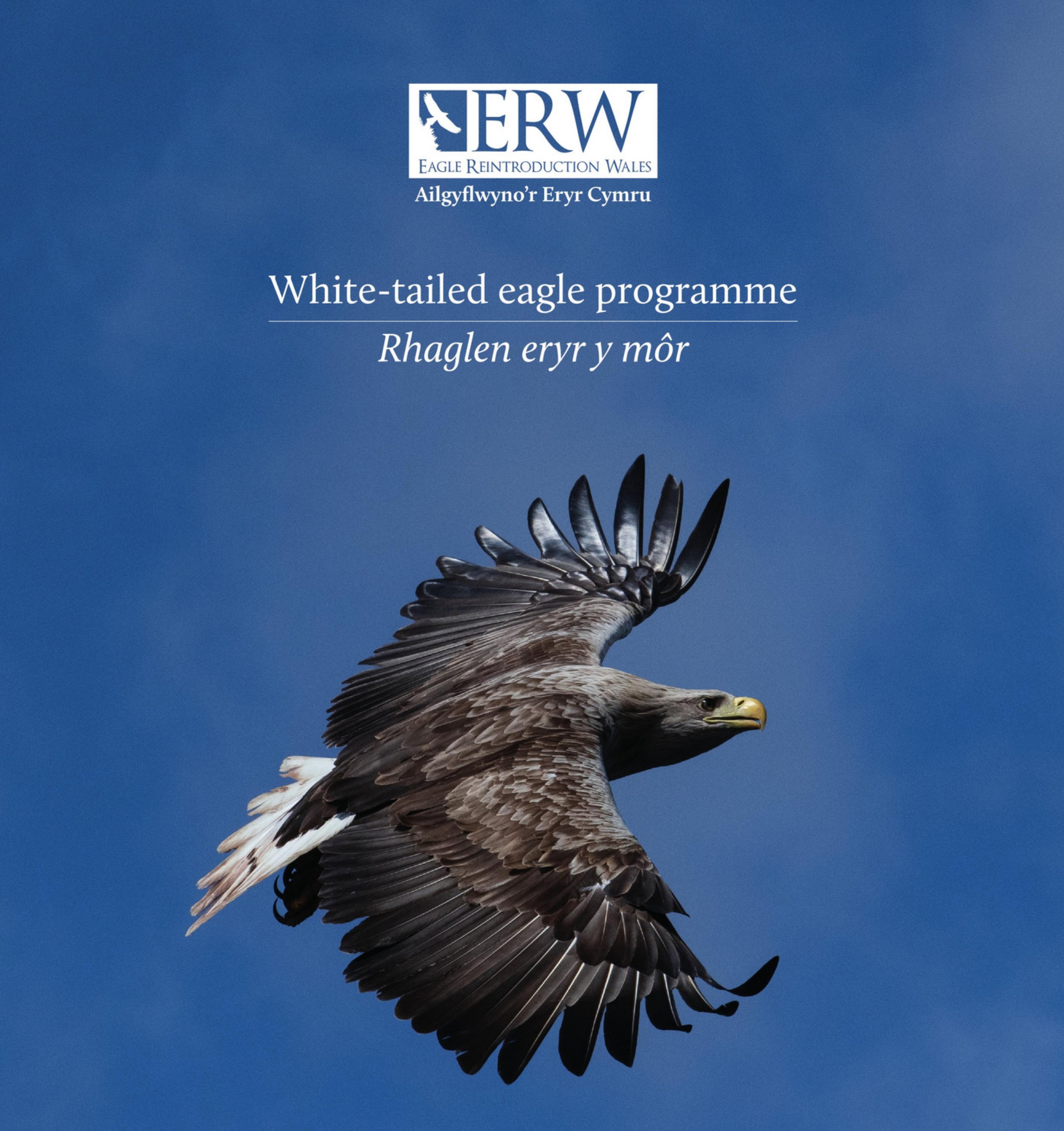White-tailed Eagle
Eryr y mor - Haliaeetus albicilla
The White-tailed eagle (Haliaeetus albicilla) is part of the Accipitridae family which includes other diurnal raptors such as hawks, harriers, and buzzards. Otherwise known as ‘sea eagles’ the White-tailed eagle is part of the sea eagle family and is our largest bird of prey in the UK. Males weigh on average 4.5kg (10lb) and females weigh on average 6.9kg (15lb). In the UK the average wingspan of a male is 2.18m (7ft) and 2.5m (8ft) for females.
The bird inhabits stretches of marine and freshwater regions such as coastlines, rivers, lakes wetlands, and estuaries. Wales is a great place to restore the White-tailed Eagle. Historically a native and widespread species, Wales lost the White-tailed eagle in the 1830s and the last known breeding pair bred at Kenfig Burrows, now known as Kenfig Nature Reserve on the Swansea Coast, South Wales.
Over 300 prey species have been recorded in the White-tailed eagle’s diet. As an aquatic prey specialist, typical prey comprises of freshwater and marine fish, waterfowl, ducks, geese, swans, gulls, cormorants, herons, and carrion. These birds prefer hunting across shallow waters but are versatile and opportunistic hunters and take a wide variety of prey including rats, rabbits, hares, frogs, and even Cuttlefish!
White-tailed eagle programme
Project status:
Our White-tailed Eagle programme has now completed all feasibility assessments to understand if the species can be restored to Southeast Wales and the Severn Estuary. All assessments have rendered a reintroduction the most acceptable option for the species and for Wales. The programme has now submitted a license to Natural Resources Wales and is awaiting an official decision by March 2026. If the programme gets the greenlight a 5-year reintroduction will launch between 2026-2030.
Project partnerships:
Durrell Wildlife Conservation Trust, Gwent Wildlife Trust and the Wildfowl and Wetlands Trust.
Junior partnerships:
British Birds of Prey Centre and Cardiff University
Project Funding:
Our White-tailed Eagle programme is currently being funded by the Ecological Restoration Fund.
Feasibility Reports for Southeast Wales:
All reports will be uploaded to the ERW website soon.
Other Research:
Lucy Rowley [2023-2026]. Understanding the genetic variation of current UK and European White-tailed eagles to inform future UK translocations. Cardiff University, PhD Thesis [Ongoing].
Andrew Peat [2023]. Population Viability Analysis to inform the reintroduction of White-tailed eagle to Southeast Wales. Cardiff University, Master Thesis [Onoging].
Gregory Miles [2023]. The spatial and temporal distribution of summer prey items for White-tailed eagles across the Severn Estuary & Bristol Channel. Cardiff University, Master Thesis [Ongoing].
Matthew Cooke [2023]. The spatial and temporal distribution of winter prey items for White-tailed eagles across the Severn Estuary & Bristol Channel. Cardiff University, Master Thesis [Ongoing].
Sophie-lee Williams, Sarah Perkins, Roy Dennis, James Byrne & Robert Thomas (2020). An evidence-based assessment of the past distribution of Golden and White-tailed Eagles across Wales. Conservation Science 2(8). Available here.
Lauren Rees (2020). Assessing Welsh public attitudes towards White-tailed Eagles in South Wales. Implications for future reintroduction. University of the West of England, Master Thesis [Unpublished].
Sophie-lee Williams [2021]. The Eagle Reintroduction Wales (ERW) project: An assessment to restore our native-lost eagles. Cardiff University, PhD Thesis. Available here.
Photo Ⓒ Jeff Smith
Restoring White-tailed Eagles to South-east Wales & the Severn Estuary
Eagle Reintroduction Wales a Durrell Wildlife Conservation Trust programme is working in partnership with Gwent Wildlife Trust and WWT {Wildfowl and Wetlands Trust}to restore this magnificent native-lost species back to the skies, coastlines, estuaries, wetlands, rivers and lakes of South-east Wales and the wider Severn Estuary.
The area has plenty of suitable habitat, natural resources and prey available for White-tailed Eagles. Other European reintroductions have highlighted that by restoring this important species, and it’s ecosystem functions, they provide wider conservation benefits to regulate and support habitat and wildlife health and resilience across aquatic ecosystems
Wouldn’t it be amazing to see the White-tailed Eagle soaring back over the skies of Modern Wales!
How do I learn more?
You can learn more about the restoration of White-tailed Eagles to Southeast Wales by reading our Frequently Asked Question {FAQ}report or by watching our Eryr Y mor Cymru webinar.
How can I get involved?
We are upgrading our ‘How to get involved?’ section for the ERW webpage. Information will be provided soon.







